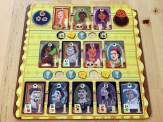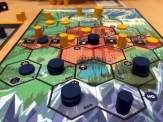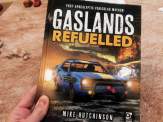| Release Date: 2019 | Players: 2 (only) |
| Designer: David Thompson, Trevor Benjamin | Length: 45-60 minutes (per scenario) |
| Artist: Roland MacDonald | Age: 12+ |
| Publisher: Osprey Games | Complexity: 2.5 / 5 |
| Plastic to Non-Plastic: 15% | Air to Components: 15% |
We had just landed in Normandy. It was the summer of 1944, but it was relatively cold. We were thousands of miles from home and the landscape was unknown to us. Yet, we had to push deeper into a country we didn’t know in our goal to push the German forces out of France. There was regular machine gun fire and mortar bombardment. It was really scary, but we remained Undaunted: Normandy by Trevor Benjamin and David Thompson from Osprey Games.
The Setting
As the introduction intimates, the game is set in the summer of 1944, shortly after the D-Day Landings on the beaches of Normandy. The United States had already lost around 29,000, with a further 106,000 wounded or missing1. The losses for the other allied nations weren’t much less. Germany lost 30,000 troops, with 80,000 wounded and 210,000 missing1. It was a brutal battle and the largest naval, air and land operation in history2 – but it was only the beginning. The Landings opened up a much-needed second front against Germany. It took just under a year after the Landings for Germany to surrender3.
As everyone knows, WWII saw an unbelievable amount of death, suffering and atrocities. The victory of the Allied Forces over Germany put an end to the Nazis’ Final Solution and lead to the formation of the United Nations4. The war saw tens of millions of people being killed, many of whom were civilians who died at the hands of Nazis who persecuted not only Jews, but also many others.
We must never forget the atrocities committed during and just before WWII by the Nazi apparatus.
The Game
In Undaunted: Normandy you either play as the United States or Germany. You play this game over a number of scenarios that represent different missions carried out by the US 30th Infantry Division. There are a number of double-sided square cardboard tiles that represent sections of terrain. They are set up in different combinations for each scenario. You also get two decks of cards, one for the US and one for Germany and a large number of different cardboard tokens. These represent objectives, troops and other elements in the game. There are also four 10-sided dice, which you use during attacks and which make this process a little more random.
The main mechanisms in Undaunted: Normandy are hand management and deck building. Every scenario starts with a different selection of cards, based on the mission played. You divide these cards further into your deck and your supply. Like in any other deck-building game you will have played, you shuffle your deck at the beginning of the game. Every round you then draw a number of cards into your hand, four in this case. You play these in any order you want on your turn and then discard them in your discard pile.
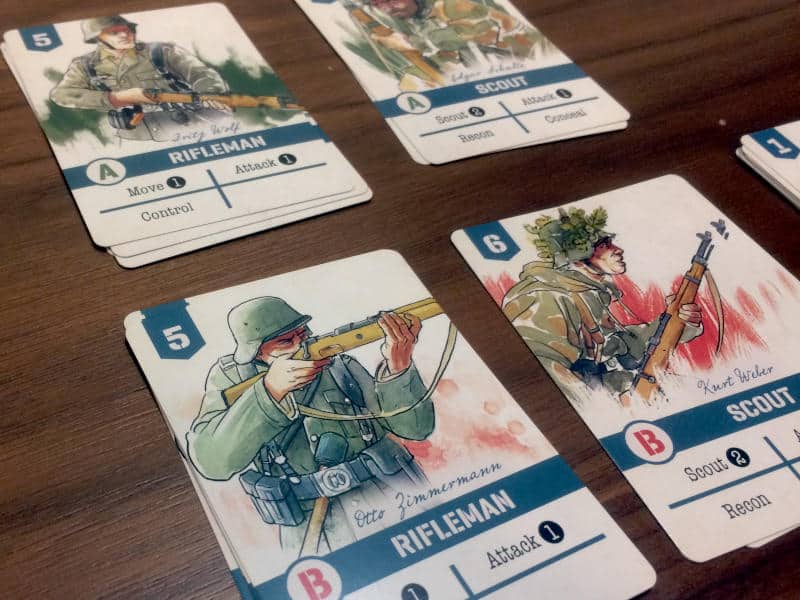
Every card has a number of actions on them and you choose one of them as you play the card. Some actions allow you to take cards out of your supply and add them to your discard pile. That’s where the “building” part comes in. You can also remove useless cards, called Fog of War cards in the game, with certain actions, which allow you to thin out your deck.
Move and Attack
Most of the time though you will want to scout the map and move your troops around – or you will choose to attack.
You can only move onto tiles that you have scouted out. So you need to move your scout units first, before you can move your other military units. However, the more tiles you scout, the more Fog of War cards you get. That represents the idea that your troops are now more spread out and therefore communication is becoming more difficult.
Attack is a matter of counting the terrain tiles between your unit and the target unit, then adding the defending unit’s defence value and the cover value of the tile the defending unit is on. So a wooded area may offer a cover value of 3, while an open field has a value of 0. You then roll a number of dice, depending on your unit and the type of attack you’re carrying out. If at least one of the dice is equal to or higher than the defence value of the unit you’re attacking, or if you’ve rolled at least one 0, then your attack was successful.
There are different types of attack, as I mentioned. You can literally try to kill someone or you can just lay down suppressive fire. The former is harder, but if successful, the other player will have to remove a card from the game. The latter is easier, but only slows down your opponent. Their unit is considered “suppressed”. That means when they’re next used, they just become active again, but don’t carry out any actions.

Get yourself a wooden Tabletop Games Blog dice tray.
Each tray is the perfect size to roll your dice, and with the soft mat, it’s really quiet, while the wooden frame makes it wonderfully sturdy.
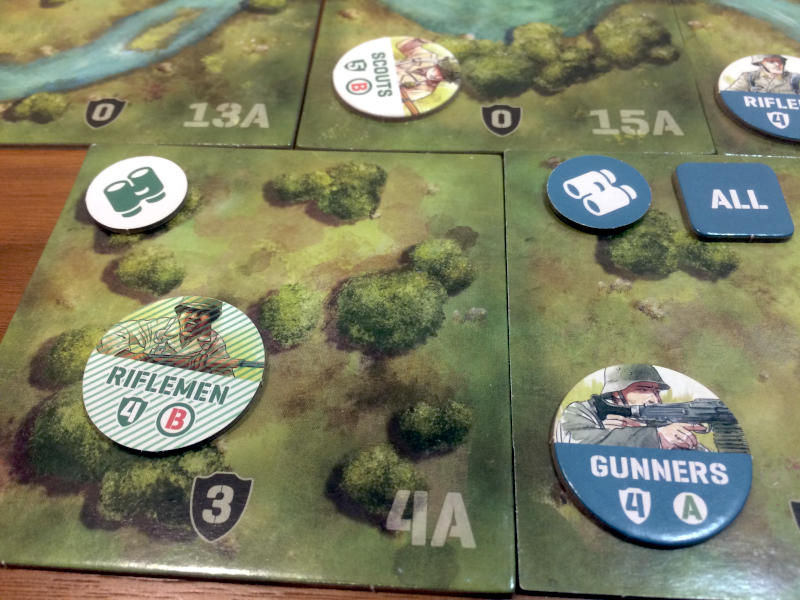
Strategy and Tactics
It is amazing how different every scenario in Undaunted: Normandy is. Depending on which side you play and what the current mission is, you may just want to lay down suppressive fire to slow down the opponent while you slowly build up your own hand. If you time it right, you can then strike with full force when you’re ready. In other missions, you just have to try and rush a win and hope for the best. There are also scenarios where you start out in the open. You quickly have to find cover, before you can co-ordinate an attack. You really have to spend a little time at the beginning of each game evaluating the map and your objectives, before deciding the best plan of action.
Some scenarios look like they’re heavily weighted towards one side rather than the other. It feels unfair. However, as you start playing, you realise that the perceived benefit isn’t actually as big as you thought. With some clever manoeuvring you quickly outflank the other player and claim the objective points you need to win.
Speaking of objective points, many scenarios’ goal is to basically conquer specific locations and control them to win. However, there is also always the option to destroy your enemy’s riflemen units. Winning that way is called pinning, because it’s only the riflemen who can control a location. So if you can’t control locations, you can never claim the objective points you need to win. It’s something to bear in mind and can be the better option in some cases.
Suprise Victory
Undaunted: Normandy sometimes feels like it will never end. Both sides have found their perfect cover and have dug themselves in. There seems to be an endless exchange of fire that slowly whittles down both players’ forces. You are about to offer a draw, when you suddenly spot an opportunity – or maybe your opponent sees something you’ve missed.
Quite often the game ended suddenly, at a point when it felt like it could continue for another half hour or more. I was often really surprised. I sometimes felt that sudden victory was just a matter of being lucky with my card draw or that the other player just had had bad luck. Other times I felt like I had found the perfect moment to strike and gained a deserved victory. In most cases, one player simply didn’t see the opportunity their opponent had and left themselves wide open.
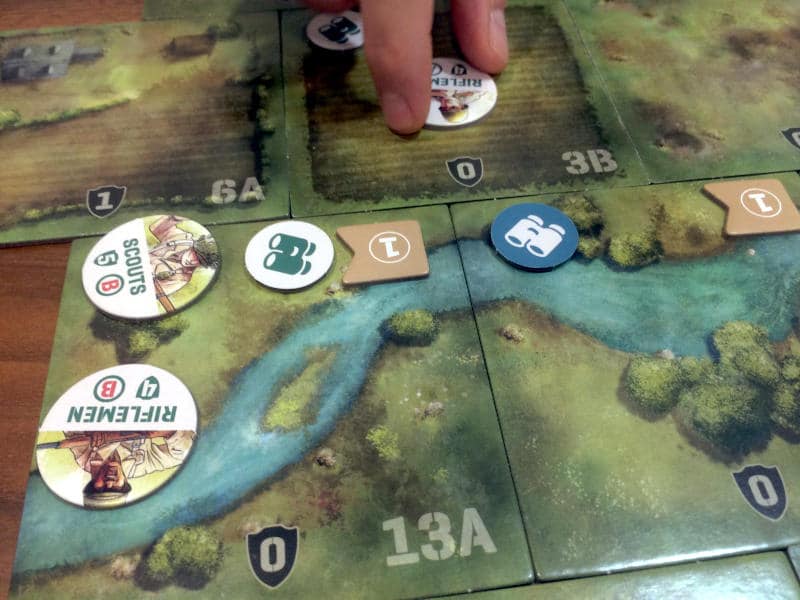
Undaunted: Normandy is really clever in that respect. You always have to make sure you’ve covered your bases. It’s easy to be lulled into a false sense of security. If you take your eye off the situation for a round, your opponent could get the opportunity they need to win.
You also need to keep an eye on the cards the other player has in their deck and which they have played. More often than not, you can use your own cards in a much better way if you know that the other player no longer has certain cards in their draw deck. It’s very much like most deck builders in that respect.
The Verdict
Placing a game against the backdrop of one of the bloodiest and most brutal wars in history is never easy. Focussing on a smaller section of WWII does make it a little easier. As the rulebook says “Undaunted: Normandy is based heavily on the US Army rifle platoons of World War II and
more specifically on the actions of the US 30th Infantry Division in Normandy from 10 June
to 13 August 1944.” However, as players, you’re still faced with re-enacting the killing of people in battle. That’s not something that’s easy to accept.
Undaunted: Normandy tries to remind players that there were real people in this war. The cards show names of soldiers “to add to the sense that you are in command of real soldiers and not pure abstractions”, as the rulebook points out. They are not necessarily names of some of the people who actually fought in the campaigns that the game’s scenarios represent, but “have been generated from names that were common in the period and are not meant to refer to any person, living or dead.”
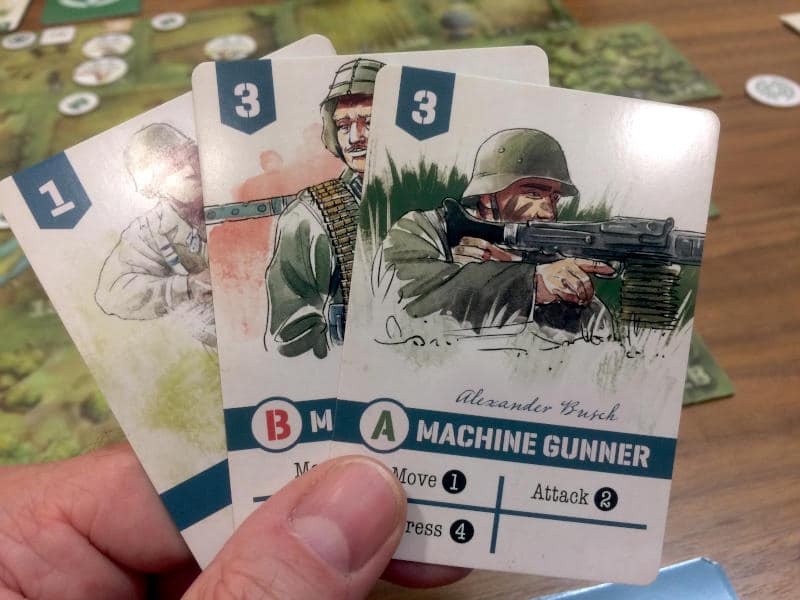
There are very few war games that really bring the brutality of war to life. In most war games, players are distanced from the death and suffering of people and Undaunted: Normandy is no different. Removing cards from play or taking tokens off the board doesn’t convey any sense of someone losing their life.
Fog of War
At the same time, you do get a small sense of the panic and chaos that can reign on the battlefield. As the commander, you know exactly what you want to happen next, but when you draw your next hand of cards, you don’t always get the option to execute your plan. It doesn’t get any easier when more Fog of War cards are added to your deck, reducing your options even further.
As you play, you do feel the helplessness that the commanders must have felt as they watched their troops being killed, without any hope of being able to help them. Of course, that is no replacement for feeling the actual horror of war. Undaunted: Normandy‘s rulebook concurs by saying that “the core mechanic of deck-building is an obvious abstraction […] and the core aim has always been to create a game that might emulate the experience of being in command of a platoon rather than its exact reality.”
A Great Experience
Bearing all of this in mind, Undaunted: Normandy does not convey the horrors of war, but as a tactical war game is a great experience. It is almost like a traditional tabletop skirmish game, but in board game form. Other than counting tiles and adding cover values, there is no measuring or endless dice rolling. People who are familiar with deck-building games will find it easy to learn Undaunted: Normandy.
There are a lot of facets that make this game attractive to a wide range of players. Tabletop skirmish players will enjoy it as much as fans of deck-building games. War gamers get a nice challenge and are able to imagine themselves as commanders in WWII. At the same time, the experience is really streamlined and requires just enough tactical thinking to keep you busy, without making the game feel drawn out. Setup can take a while, but the gameplay itself is really streamlined and turns are over pretty quickly.
Every scenario takes about an hour to play and in that relatively short amount of time, you will have a satisfying experience. The large number of scenarios also slowly introduce you to new mechanisms, so you can really learn the game as you play.
I know there are now many games in the Undaunted series and more are coming out soon, but I can confidently say that starting with Undaunted: Normandy is a good option. If you like this game, then you’ll want to try one of the others. Personally, I got my eye on Undaunted: Stalingrad which introduces even more mechanisms and concepts, creating more of a legacy game experience. Anyway, please give Undaunted: Normandy a try and see where it takes you.
Sources
- Estimated Battle Casualties during the Normandy Invasion on June 6, 1944: https://www.
britannica. com/ story/ estimated-battle-casualties-during-the-normandy-invasion-on-june-6-1944 - The 10 Things you Need to Know about D-Day: https://www.
iwm. org. uk/ history/ the-10-things-you-need-to-know-about-d-day - D-Day: Facts on the Epic 1944 Invasion That Changed the Course of WWII: https://www.
history. com/ news/ d-day-normandy-wwii-facts - World War II (Wikipedia): https://en.
wikipedia. org/ wiki/ World_ War_ II
Rules Teach Video
If you enjoyed this article, please have a look at my support page to see how you can help keep the blog going.
Useful Links
- Undaunted: Normandy: https://ospreypublishing.
com/ undaunted-normandy - Osprey Games: https://ospreypublishing.
com/ store/ osprey-games/ - BGG listing: https://boardgamegeek.
com/ boardgame/ 268864/ undaunted-normandy - Rules teach video: https://youtu.
be/ xxnWi8SVRfI
Transparency Facts
I feel that this review reflects my own, independent and honest opinion, but the facts below allow you to decide whether you think that I was influenced in any way. Please also read my Ethics Statement for more information.- I bought and paid for the game myself.
- At the time of writing, I have not received financial support from the publisher or anyone working on their behalf.
Audio Version
Intro Music: Bomber (Sting) by Riot (https://www.
Music: Dark Secrets (DECISION) by Sascha Ende
Free download: https://filmmusic.
License (CC BY 4.0): https://filmmusic.
Artist website: https://www.
Music: Oppressive Gloom by Kevin MacLeod
Free download: https://filmmusic.
License (CC BY 4.0): https://filmmusic.
Artist website: https://incompetech.


